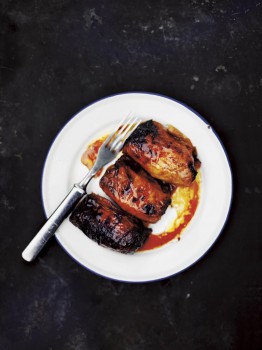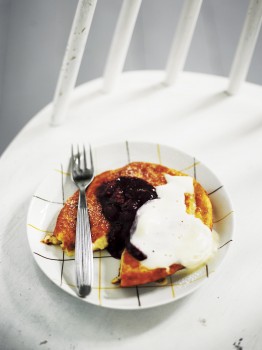Slowly does it
5 November 2009 | Reviews

Straight from the oven: cabbage rolls. – Photo: Sami Repo
Mummola
[Grandma’s house]
(food: Hans Välimäki, photographs: Sami Repo, text: Mikko Takala, graphic design: Timo Numminen)
Helsinki: Otava, 2009. 224 p., ill.
ISBN 978-951-1-23930-7
€ 40
How paradoxical: in the past couple of decades, numerous internationally famous gourmet restaurants have sprung up in Finland, and at the same time it’s harder than ever to find ordinary, well-prepared ingredients for cooking at home.
It’s hard to get used to the fact that foods like beef and lamb kidneys, sweetbread, and cheaper cuts for use in stews and soups have made way for cheap Brazilian steaks on special offer, even at the largest stores’ meat counters. There’s no point in looking for whole chickens (and certainly not organic poultry), let alone whole, locally caught fish. The last time I asked at the fish counter of my local market if they might have any salmon heads and bones for chowder, the seller looked for a moment like she might summon security. The consumer wasn’t consulted when ‘taste’ and ‘variety’ were replaced by ‘ease’ and ‘speed’.
At the same time as the public was – somewhat sluggishly – horrified late in the summer by food scandals in large Finnish grocery chains (middle-aged fish, off-tasting meat put back on sale after a dunk in camouflaging marinade) Hans Välimäki’s Mummola appeared. To all outward appearances it breathes nostalgia for the last century: old-fashioned dishes, old-fashioned food, Grandma’s rag rugs, and an oilcloth on the table.
Välimäki doesn’t shy away from paradox. He himself is Finland’s most famous gourmet chef, and his Helsinki restaurant, Chez Dominique, was the first in Finland to receive two stars from the Michelin guide, but his book is a defence of just the kind of home cooking that is being forgotten somewhere between gourmet restaurants and fast food outlets. The recipes are old-fashioned, too – or are they?
Grandma’s house, of course, refers to the idealised stereotypical image we all have of the place, regardless of whether our real grandma was a plump, happy, grey-haired baker of sweet rolls or an early retiree who took golf vacations in Spain. Välimäki freely admits that his late grandmother was the worst cook ever. Grandma’s house simply stirs up memories of tastes and smells from a vanished time. Life was no better than it is now, but perhaps the food really was superior?
When we talk about Grandma’s home cooking, we’re actually talking about real gourmet cooking. Every top restaurant is proud of its use of the freshest, highest quality raw ingredients, often purchased the same day from the farmer’s market or market hall. They make food by hand without any additives and – if the recipe calls for it – with slow, patient preparation, even if television cooks prefer to perform their work at a manic, split-second pace. Pre-processed or artificial ‘lite’ products have no place in Välimäki’s kitchen. ‘The shorter the list of ingredients, the better the food,’ he writes. But even he doesn’t make impossible demands on his readers and fellow cooks. You may buy your chicken plucked, your filo dough ready-made and frozen.
It’s striking how many of the dishes there are in Mummola that are eschewed by the average contemporary child, even the average adult. The recipes begin with kesäkeitto (summer soup) – from my observations one of the most hated of school meals, because its institutional version is made with tasteless frozen vegetables cooked to the consistency of wet cardboard. It brings to mind that new saying about the bleak Finnish climate: Summer is short, but at least there’s not much snow. Välimäki’s summer soup is a seasonal item on the menu of his restaurant. It is always made from fresh vegetables, which in Finland’s short summers are actually roughly equivalent to the French idea of ‘les primeurs’ – spring vegetables.
Many of the other foods in Mummola have an international background. One of the most surprising is stuffed cabbage rolls, still among Finns’ favourite foods, which those familiar with south-eastern European and Near Eastern food will recognise as dolmas. They did, in fact, come to Finland from Turkey: when the Swedish king Charles XII lost to Russia at the Battle of Poltava three hundred years ago, the surviving Swedes and Finns withdrew to Swedish-allied Turkey, and while waiting to return home, got to know this delicious dish with its ground meat stuffing. In the north it changed to a certain extent, and rolls of lightly cooked cabbage leaf were generally dipped in a mixture of butter and treacle that gave them a distinctly delicate roasted flavour.
Veriohukaiset, blood pancakes, are the favourite of many, the horror of others. It takes skill to make them, so many people buy the cardboard-flavoured ready-made ones crammed with additives. Making real blood pancakes is a precise process: the beef blood, flour, and other ingredients must be mixed assiduously so that the blood doesn’t coagulate. The result is light, crisp, and delicious, particularly with lingonberry jam.
There was a time a few years ago when school meals were part of the Finnish school system’s success story, considered as much a part of successful schools as Finland’s PISA (Programme for International Student Assessment) citations. Välimäki doesn’t quite share the national pride in school lunches – he prefers Sweden as a model: rural schools with their own cooks who prepare meals from local ingredients. Fostering competition and centralising food services in large production units as Finland often does, might produce savings in the council bookkeeping, but the Swedish model has created a few local jobs, revived agriculture, provided tastier, healthier food, and given children welcome information about where food comes from. Some eaters stuck on junk food and processed foods may expand their boundaries: taste fish that hasn’t been frozen in the form of a greasy stick, vegetables served in a form other than as a pizza topping, meat and organ meats that haven’t been ground up and stuffed in a fatty sausage.
The most impressive thing about Mummola, however, is not its old-fashionedness or its polemic defence of Finnish food culture. Most impressive are the details that reveal how skilfully and creatively Välimäki has ‘read’ Finnish food culture. The list of ingredients itself may be as plain as in any Finnish grandma’s recipe book, but the hand of a chef is revealed in the tiny details of their preparation techniques – as, for example, in the recipe for baked apples filled with caramelised sugar. Some of the recipes, on the other hand, are simply so good – in all their simplicity – that they cannot be improved upon.
Translated by Lola Rogers
Below: the recipes for cabbage rolls and pancake from the Åland islands: proper winter food, bon appetit!
Kaalikääryleet / Cabbage rolls
I confess that I really seldom make these, as they are very fiddly – however, the result is usually worth the trouble.
With cream, the cooking juices make excellent sauce, but the rolls taste great just as they are, with boiled potatoes. [And lingonberry jam. The Editors.].
1.5kg cabbage
1 onion
1dl rice
1 stock cube
6dl cabbage cooking liquid
600g minced meat: half pork, half beef
1tsp ground white pepper
1 egg
1 egg yolk
2dl milk
2tsp salt
50g butter
2tbsp treacle
(3dl double cream, 3tbsp of flour)
After removing the hard stems from the cabbage, boil in lightly salted water, removing the leaves as they soften. Save the cooking liquid.
Chop the onion and lightly fry in the butter. Boil the rice according to the packet instructions, adding the stock cube.
Mix the mince, rice, spices, onion, egg, egg yolk and milk. Put about three spoonfuls of the mixture on each cabbage leaf. Roll the leaves into parcels and put them, seams down, into a buttered oven dish. Melt the butter and add the treacle and pour the mixture over the rolls.
Bake the rolls in 180°C oven, about 45 minutes. Turn them over and bake for approximately 30 minutes. If the rolls begin to dry up, pour cooking liquid on them. Cover the dish with aluminium foil and bake for another 15 minutes.
(For cream sauce use the baking juices, 3dl of double cream and 3tbsp of flour.)

As Grandma used to make it: pancake. – Photo: Sami Repo
Ahvenanmaan pannukakku / Aland pancake
Ahvenanmaa [the Aland islands, between Finland and Sweden] is a Finnish jewel that, according to Finns, might just as well belong to Sweden [as the population speaks mostly Swedish there anyway. The Editors]. The Swedes agree. The Aland people are not asked. This is one of the best home-cooked desserts.
3dl rice porridge
2tbsp of butter
4 eggs
0.5l milk
a pinch of salt
2tbsp of sugar
2tbsp ground cardamom
2 dl flour
Make the porridge according to the packet instructions. Cover a baking sheet with greased parchment paper. Heat the oven to 225°C.
Whisk the eggs, then add the rest of the ingredients. Pour the mixture onto the baking sheet and bake for 15–20 minutes or until the top of the pancake has properly browned. Serve with whipped cream and jam.
Tags: cookery
1 comment:
Trackbacks/Pingbacks:
-
Matthew Goudge
22 October 2010 on 9:48 pmChef Hans Välimäki – Started His Culinary Career at Young Age […] Chef Hans Välimäki’s Cabbage Rolls (from Mummola) […]

14 November 2009 on 12:11 am
It is quite interesting to see that Finland and Turkey have such a historical relation through food! I was always wondering how it could be similar, and now I’v found the reason.